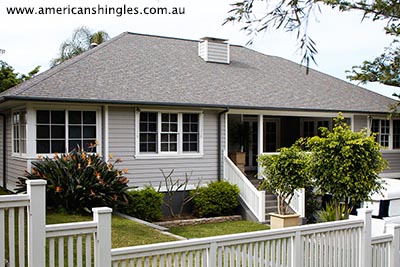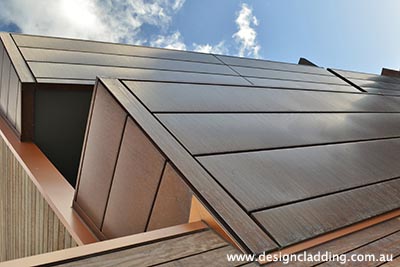They can be gorgeous!
This part of the building process outlines the many choices you have for roof claddings and describes the manner in which they are fixed or constructed.
These choices need to be made in the early stages of design, and can be included in a finishes schedule attached to the specification document. The finishes selected will determine the house construction, described previously in parts 1 - 3 of Understanding House Structures.
It is very important at this stage to select a roof that is not only conducive to the style of home you have designed but also a colour that will match your windows, wall cladding and other external fixings.
After the roof & wall structures as well as the doors and windows have been installed, the exterior wall and roof cladding can be applied, rendering the building secure. This is often referred to as the 'lock-up stage'. When the building has reached lock-up the interior wall cladding can be installed and then all other internal fixings.
For many design choices, the "rule of threes" is a good starting point; i.e. never have more than a maximum of three materials, three textures or three colours in one field of view at the same time.
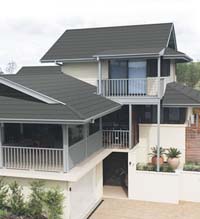
Boral terracotta shingles
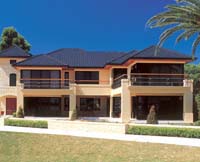
Bristile Vienna terracotta tiles
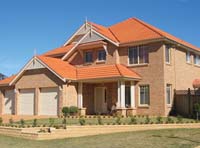
Wunderlich Marseille
terracotta tile
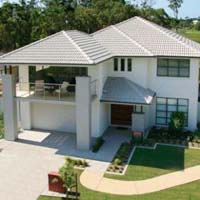
Bristle concrete tile
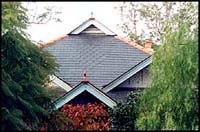
Carmen slate tiles
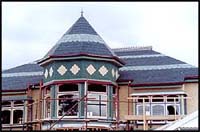
Carmen slate tiles
The style of the roof is often dictated by the style of the house. However the colour of the roof needs careful consideration because there are conflicting influences at play.
The lighter the roof, the greater the heat reflection. However very light coloured roofs can destroy the look of a house and make the roof stand out unnecessarily.
The best colours for roofs are likely to be mid range to light colours than compliment the window frames, e.g. dark grey window frames and a light grey roof, or maybe compliment the brick work, e.g. light beige bricks and a dark beige roof. Alternatively there might be a feature wall of light terra cotta colour and the roof is a similar but slightly darker colour. Whatever the approach, the roof colour in some way needs to be connected to, or compliment, the rest of the house colour.
Metal roofs
Roofs sheets are a good choice for light weight modern homes as well as solid traditional homes. They are also used a lot in earthquake areas and distant locations where transport impacts significantly on costs.
Corrosion resistant metal sheets are available in:
- Galvanized iron, copper and zinc (works well with contemporary or lightweight house)
- Steel composites such as Zincalume (works well with contemporary or lightweight house)
- Metal tiles such as CoRoofs (which have polyester coated surfaces). Being a tile shape, these sheets work with brick. They are strong, lightweight and can often be installed over an existing roof.
- Sheets of copper or zinc that look like large tiles are also interesting, durable materials for contemporary buildings but top of the line when it come to costs. (see: Euroclad's website).
All of the roof sheeting types mentioned above are all available in long lengths. Colorbond and CoRoofs' metal tiles are available in a variety of coloured polyester coatings and grades.
Corrugated steel sheet roofing is the only type of roof sheeting that can be curved and can come pre-curved if the radius is considerable. Roofs sheets are the best material for catching water run-off, however sheet metal roofing is noisier if left uninsulated.
If you are considering roof sheeting you may possibly be limited in your profile selection if the home is located in a cyclonic area (the sheeting may also require special fixings).
Colorbond
Painted polyester coated steel such as Colorbond (works well with contemporary or lightweight house) and great for homes in regional or beach side environments. "Colorbond comes in different grades and which one is right for your home will depend on the air environment around your property. The highest grade is stainless steel (essential in beach side or industrial areas) which costs a great deal more than the entry level sheeting.
Fibre Cement Tiles
Eternit slate tiles are a synthetic, fibre-cement form of roof tile that is reversible and available in different rectangular sizes as well as a diamond shape. It is cheaper and lighter than natural slate.
Slate Tiles
Natural slate tiles retain their classy appearance over their exceptionally long life (120 years) and can be easily and neatly cut, re-nailed and repaired. Natural slate tiles are available in shades of grey, green/grey and blue. While slate has been used in traditional style residential housing (e.g. Federation), it can also look very good in contemporary designs where it works well with rendered masonry, smooth, slim line brick and exposed Cor-ten steel or galvanized iron.
There are also patented slate roofing systems such as, NuLoK which look great, are light and easy to install on a galvanized iron frame; one type has built in solar panelling.
Slate is at the high end of roofing costs but if you have long term plans for your home it's definitely worth considering.
Shingles
Bitumen shingles are another option for a different look and can look classy, timeless and the product is extremely durable. See this article on American Shingles.
Terracotta tiles
Terracotta tiles are a very popular roofing type in Australian but they can be an expensive option in comparison to steel and concrete tiles. Depending on the profile Australian Terracotta tile cannot be beaten for their good looks and durability.
Terracotta tiles are available in many different profiles and colours. They are well suited to the hot Australian climate - at least in areas where there are no cyclonic winds or snow. CSR make a range of Wunderlich tiles as do Boral and Bristile.
Cement Tiles
Concrete tiles can look fabulous. All the terracotta manufacturers make these cheaper concrete tiles that have similar profiles to terracotta tiles. Concrete tiles are however more porous, generally don't have the same luster as terracotta and fade quickly in comparison to terracotta tiles, due to the paint being applied to the surface and not impregnated.
Roof flashing
Flashing is also an integral part of a successful roofing system. Flashing types vary from solid sheets to malleable membranes that are installed to direct water away from the internal space of the home.
Flashing may be exposed or concealed. Exposed flashing is usually of a sheet metal, such as aluminium, copper, painted galvanized steel, stainless steel, zinc alloy, lead or lead-coated copper.
For further information read our roof flashing article. This article will provide you with a solid understanding about flashing types and materials, and which one is most suitable for your job.
